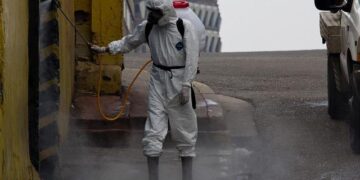Hazmat Response at George Washington Carver Middle School
A routine science experiment at George Washington Carver Middle School in Los Angeles took an alarming turn on Wednesday, leading to a significant hazmat response and the treatment of at least eight individuals. Emergency services quickly arrived after reports indicated that hazardous materials were involved in the school’s laboratory incident. Authorities confirmed that those affected exhibited symptoms requiring urgent medical care, raising serious questions about safety protocols within educational settings. As investigations unfold, the community is left searching for clarity regarding the incident and what measures will be implemented to avert similar situations in the future.
Community Reaction to Lab Incident
The occurrence at George Washington Carver Middle School triggered an immediate hazmat response as several individuals displayed signs consistent with chemical exposure. Emergency personnel treated a minimum of eight people for respiratory issues and skin irritations. Parents and local residents gathered outside the school, visibly distressed by the situation as authorities secured the area for safety reasons. This event has sparked considerable concern within the community regarding whether current safety protocols are sufficient in educational institutions.
In light of this incident, school district officials released a statement reaffirming their dedication to safety and transparency while cooperating fully with local authorities during their investigation into what transpired. Preliminary evaluations suggest potential mishandling or improper storage of chemicals may have contributed to this alarming event, prompting discussions about laboratory practices among both students and staff members. The district plans to convene an emergency meeting aimed at addressing community concerns with key discussion points including:
- Chemical Safety Protocols: Review existing guidelines for chemical storage and handling.
- Emergency Response Training: Enhance training programs for staff on responding effectively to hazardous situations.
- Parental Communication: Develop a more efficient communication strategy during emergencies.
Scrutiny of Safety Protocols After Treatment of Affected Individuals
The unsettling incident has prompted a thorough review of existing safety protocols across educational facilities following treatment provided to eight individuals exposed to hazardous substances. Experts stress that robust safety frameworks are essential, which should include:
- Regular Safety Drills: Ensure all staff members and students are well-acquainted with emergency procedures through frequent drills.
- Incident Reporting Systems: Establish effective mechanisms for swiftly reporting any safety concerns encountered.
- Proper Equipment Usage Training: Provide comprehensive training on safe handling practices concerning chemicals and materials.
- Cyclical Reviews: Regularly assess and update safety protocols based on recent incidents or feedback received from stakeholders.
A prompt response from school officials includes immediate training sessions designed to reinforce these critical measures. Initial assessments have already identified gaps in communication during this crisis that may have worsened conditions; thus, a detailed review is currently underway focusing on specific areas such as:
| Focus Area | Current Status | Recommended Action |
|---|---|---|
| Staff Training | Inconsistent | Implement mandatory workshops focused on safety procedures |
Strategies for Improving School Safety Post-Hazmat Incident
The recent hazmat situation underscores an urgent need for schools like George Washington Carver Middle School to reassess their health standards rigorously. To bolster emergency preparedness effectively, institutions should consider adopting these vital strategies:
- Frequent Safety Drills: Conduct regular drills involving both faculty members and students so they can become familiarized with proper responses related specifically to hazardous material emergencies .
- Enhanced Ventilation Systems: Upgrade laboratory ventilation systems aimed at reducing exposure risks associated with harmful substances during experiments .
- Comprehensive Training Programs: Offer extensive training sessions tailored towards teachers/staff covering safe handling techniques alongside emergency response methods .
- Clear Communication Plans: Establish systematic communication strategies designed explicitly around informing parents/guardians promptly throughout any unfolding crises .
< / li >
< / ul >
Additionally , engaging local emergency services can enhance collaboration efforts when managing crises effectively . Schools might explore partnerships encompassing :
< table class = " wp - block - table " >
< head >
< tr >
< th >< strong > Partnership Type< / strong >
< th >< strong > Benefits< / strong >< tbody >< tr >< td >< strong > Local Fire Department< / strong >< td On-site-training-and-support-during-hazardous-material-incidents="" benefits="">The lab incident occurring recently has raised substantial concerns regarding student welfare within our communities , prompting swift action from medical professionals along side first responders alike . With multiple cases requiring treatment due exposure factors involved , it becomes increasingly clear how crucial maintaining rigorous adherence towards established health & security regulations truly remains across all academic environments moving forward ! As investigations continue into root causes behind such events taking place , relevant parties must prioritize ensuring utmost protection afforded toward both pupils & educators alike while simultaneously keeping everyone informed via official channels whenever new developments arise! For ongoing updates surrounding this evolving narrative please visit abc7.com regularly!































